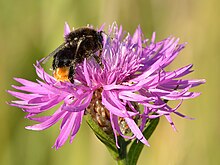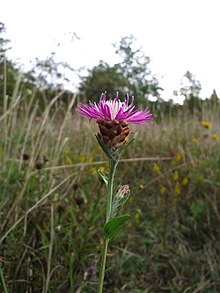Meadow knapweed
| Meadow knapweed | ||||||||||||
|---|---|---|---|---|---|---|---|---|---|---|---|---|

Meadow knapweed ( Centaurea jacea ) |
||||||||||||
| Systematics | ||||||||||||
|
||||||||||||
| Scientific name | ||||||||||||
| Centaurea jacea | ||||||||||||
| L. |
The meadow knapweed ( Centaurea jacea ), also called common knapweed , is a species of plant that belongs to the genus of knapweed ( Centaurea ) from the subfamily of Carduoideae in the family of the Asteraceae .
description
The perennial herbaceous plant reaches a height of 30 to 70 cm. The upper leaves are undivided and alternate . The lower leaves are pinnately pinnate.
The flower heads are between 2 and 4 centimeters wide and consist of 60-100 violet tubular flowers , of which the marginal ones are greatly enlarged and sterile. The bracts are clearly separated and completely cover the following bracts. These are black-brown to whitish, with entire margins or slashed, fringed and rounded. The fruits have no pappus .
The plant contains tannins .
Depending on the region and subspecies, it blooms from late May to October. Fruit ripening is from June to October.
The chromosome number of the species is 2n = 44 or 22.
ecology
The meadow knapweed is a perennial hemicryptophyte (stem plant). Vegetative propagation through root shoots is possible.
There are flowers of the "cup flower type". The plant is trio (Triozisch) d. H. In addition to plants with hermaphroditic flowers, which are noticeable for their greatly enlarged marginal flowers and stunted nectaries , there are also purely male and purely female plants. A variety of pollinators can be observed, for example: bees , bumblebees , butterflies and hoverflies . The maximum flower visit takes place at 3 p.m. Allegedly, self-pollination should be possible through the curvature of the stylus .
The achenes can also be spread by the wind without pappus , but at best as a wind spreader. It is mainly spread randomly through grazing animals, alongside spread through ants .
Occurrence
The species is common in Eurasia, with a distribution focus in the central and southern areas. As the site is semi-dry grasslands , meadows, pastures and roadsides preferably with clay soils. In the Allgäu Alps in Bavaria, it rises to the west ascent to the Hochgrat near Oberstaufen up to 1720 m above sea level.
Systematics
The species is very variable and is considered insufficiently researched. It forms hybrids , especially with the blackish knapweed ( Centaurea nigrescens ). Some of the following subspecies could be such hybrids:
- Comb shed Meadow knapweed ( Centaurea jacea subsp. Subjacea (Beck) Hyl. )
- Fiederschuppen-meadow knapweed ( Centaurea jacea subsp. Macroptilon (Borbás) Hayek )
- Light shed Meadow knapweed ( Centaurea jacea subsp. Gaudinii (Boiss. & Reuter) Gremli )
- Common meadow knapweed ( Centaurea jacea subsp. Jacea )
- Narrow Leaf Meadow knapweed ( Centaurea jacea subsp. Angustifolia (DC.) Gremli )
According to Euro + Med, the following subspecies can be distinguished:
- Centaurea jacea subsp. angustifolia (DC.) Gremli
- Centaurea jacea subsp. banatica Hayek : It occurs in Hungary, Romania and on the Balkan Peninsula.
- Centaurea jacea subsp. dracunculifolia (Dufour) A. Bolòs : It occurs in Spain and France.
- Centaurea jacea subsp. forojulensis (Poldini) Greuter : It occurs in Italy.
- Centaurea jacea subsp. gaudinii (Boiss. & Reut.) Gremli : It occurs in North Africa, France, Italy, Sicily, Switzerland, Austria and on the Balkan Peninsula.
- Centaurea jacea subsp. haynaldii (Hayek) Hayek : It occurs in Croatia, Bosnia-Herzegovina and Albania.
- Centaurea jacea subsp. jacea
- Centaurea jacea subsp. julica (Hayek) Greuter : It occurs in Italy and Slovenia.
- Centaurea jacea subsp. substituta (Czerep.) Mikheev : It occurs in Ukraine, Moldova, Georgia and Russia.
- Centaurea jacea subsp. timbalii (Martrin-Donos) Brown-Blanq. : It occurs in Portugal, Spain, France, Germany, Italy, Belgium and the Netherlands.
- Centaurea jacea subsp. vinyalsii (Sennen) O. Bolòs & al. : It occurs in Spain.
- Centaurea jacea subsp. weldeniana (Rchb.) Greuter : It occurs in Italy and on the Balkan Peninsula.
Revised the Centaurea-jacea group in Germany
The first results of a revision have meanwhile been presented for the clans of this form-rich species in Germany, but they are still of a preliminary nature. It turns out that fertile hybrids occur between practically all species of the Centaurea jacea group, some of which can be regarded as "stabilized". These were given Artrang. In addition, there are numerous, obscure hybrid complexes in which it can no longer be determined which species were involved in detail. The section "Jacea" within the genus Centaurea is now divided into several separate species, some of which are only provisionally named:
- Eastern narrow-leaved knapweed ( Centaurea pannonica (Heuff.) Simonk. Subsp. Pannonica )
- Western Narrow knapweed ( Centaurea pannonica subsp. Approximata (Rouy) GHLoos )
- Low meadow knapweed ( Centaurea humilis closet )
- Combed weak knapweed ( Centaurea semipectinata )
- Brandenburg knapweed ( Centaurea brandenburgica )
- Common meadow knapweed ( Centaurea vulgaris )
- Deceptive knapweed ( Centaurea decipiens Thuill. )
- Small feather knapweed ( Centaurea microptilon Godr. & Gren. )
- Western knapweed ( Centaurea diluvialis Soest )
- Late blooming knapweed ( Centaurea serotina Boreau )
use
The meadow knapweed is one of the characteristic and widespread flowers of species-rich, extensively used hay meadows and hay meadows and tolerates mowing twice or multiple grazing with little footfall. The first (mowing) use can take place early from May to the end of June, provided that the second cut does not take place before maturing, depending on the region, this is mid-August to mid-September. Because of its high content of tannins, however, it is of minor importance as a forage crop.
The meadow knapweed is used today in several state agricultural programs as an indicator of the quality of grassland.
Common names
For the meadow knapweed there are or existed, in some cases only regionally, the other German-language common names : wild muskrat ( Switzerland ), Bismaschütz ( St. Gallen near Obertoggenburg ), Bruchsanikel, black flake, flake herb ( Thuringia ), Gasagachnöpf (Switzerland ), Hartkopp ( Eifel near Altenahr ), Knopfblume (Eifel near Dreis ), Knopfwurz, Swartho ( Middle Low German ), Swartwort (Middle Low German), Trummaschlägel (St. Gallen), Trummachnebel (St. Gallen near Werdenberg and Sargans ) and Wannebobbele (Switzerland) .
literature
- Gunter Steinbach (Ed.), Bruno P. Kremer u. a .: wildflowers. Recognize & determine. Mosaik, Munich 2001, ISBN 3-576-11456-4 .
- Manfred A. Fischer, Wolfgang Adler, Karl Oswald: Excursion flora for Austria, Liechtenstein and South Tyrol . 2nd, improved and enlarged edition. Province of Upper Austria, Biology Center of the Upper Austrian State Museums, Linz 2005, ISBN 3-85474-140-5 , p. 935-936 .
- Margot Spohn, Marianne Golte-Bechtle: What is blooming there? The encyclopedia: over 1000 flowering plants from Central Europe. Kosmos, Stuttgart 2005, ISBN 3-440-10326-9 .
Individual evidence
- ^ Erich Oberdorfer : Plant-sociological excursion flora for Germany and neighboring areas . 8th edition. Stuttgart, Verlag Eugen Ulmer, 2001. ISBN 3-8001-3131-5 .
- ^ Centaurea jacea at Tropicos.org. In: IPCN Chromosome Reports . Missouri Botanical Garden, St. Louis
- ↑ a b c Ruprecht Düll , Herfried Kutzelnigg : Pocket dictionary of plants in Germany and neighboring countries. The most common Central European species in portrait . 7th, corrected and enlarged edition. Quelle & Meyer, Wiebelsheim 2011, ISBN 978-3-494-01424-1 , p. 203-204 . .
- ↑ Erhard Dörr, Wolfgang Lippert : Flora of the Allgäu and its surroundings. Volume 2, IHW, Eching 2004, ISBN 3-930167-61-1 , p. 647.
- ↑ a b c d e f g h i j k Werner Greuter (2006+): Compositae (pro parte majore). - In: W. Greuter & E. von Raab-Straube (ed.): Compositae. Euro + Med Plantbase - the information resource for Euro-Mediterranean plant diversity. Datasheet Centaurea jacea In: Euro + Med Plantbase - the information resource for Euro-Mediterranean plant diversity.
- ↑ a b Götz Heinrich Loos: Centaurea. In: Henning Haeupler, Thomas Muer: picture atlas of fern and flowering plants in Germany . Ed .: Federal Agency for Nature Conservation (= The fern and flowering plants of Germany . Volume 2 ). Eugen Ulmer, Stuttgart (Hohenheim) 2000, ISBN 3-8001-3364-4 , pp. 520-524 .
- ^ Sabine Heinz, Franziska Mayer, Gisbert Kuhn: Species-rich grassland recognition and assessment. (PDF; 5.7 MB) In: LFL information. Bavarian State Research Center for Agriculture (LfL), Freising, [email protected], July 2012, accessed on July 24, 2018 .
- ^ Georg August Pritzel , Carl Jessen : The German folk names of plants. New contribution to the German linguistic treasure. Philipp Cohen, Hannover 1882, page 87. ( online ).
Web links
- Centaurea jacea L., meadow knapweed. In: FloraWeb.de.
- Meadow knapweed . In: BiolFlor, the database of biological-ecological characteristics of the flora of Germany.
- Profile and distribution map for Bavaria . In: Botanical Information Hub of Bavaria .
- Centaurea jacea L. s. st. In: Info Flora , the national data and information center for Swiss flora . Retrieved June 19, 2016.
- Centaurea jacea subsp. angustifolia Gremli In: Info Flora , the national data and information center for Swiss flora . Retrieved June 19, 2016.
- Centaurea jacea subsp. gaudinii (Boiss. & Reut.) Gremli In: Info Flora , the national data and information center for Swiss flora . Retrieved June 19, 2016.
- Distribution in the northern hemisphere
- Thomas Meyer: Knapweed data sheet with identification key and photos at Flora-de: Flora von Deutschland (old name of the website: Flowers in Swabia )

